This post may contain affiliate links.
Persian-style spaghetti, or Makaroni, is a beloved comfort dish that brings together the best of two worlds. The heartiness of Italian pasta and the bold, aromatic flavors of Persian cuisine. This a staple in many Iranian households, is much more than just spaghetti with meat sauce. The key to Makaroni’s unique taste is in the spices and cooking techniques that transform a simple pasta dish into something truly special.
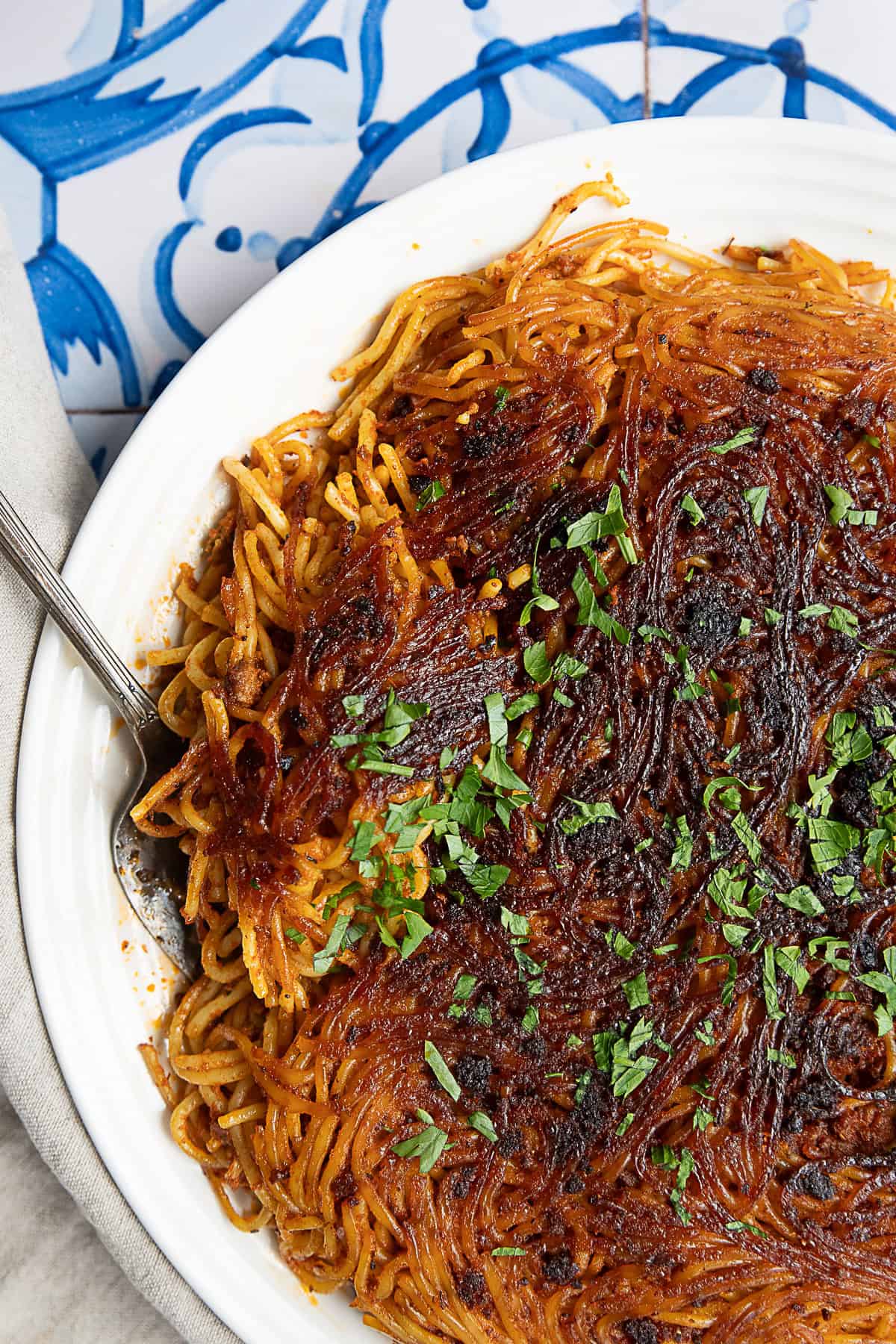
Imagine tender spaghetti mixed with a rich, spiced tomato and ground beef sauce, all cooked together to create a crispy tahdig. The tahdig is a golden layer of crunchy pasta at the bottom of the pot. Whether you’re new to Persian cuisine or looking to recreate a taste of home, this recipe is an easy, yet flavorful introduction to a dish that’s sure to become a family favorite. Other delicious Persian tahdig recipes to try are Persian potato tahdig, lubia polo (green bean mixed rice) and zereshk polo morgh (barberry rice with chicken)
Table of Contents
Recipe Highlights: Makaroni
Cultural Influence: A Persian twist on Italian pasta with rich, aromatic flavors
Primary Cooking Technique: Sautéing and steaming, and creating a crispy tahdig
Suitable For: Meat lovers, families, those seeking comfort food with a unique twist
Dominant Flavor Profile: Savory with warm spices, tender meat, and a hint of sweetness from the tomato sauce
Skill Level Required: Beginner-friendly
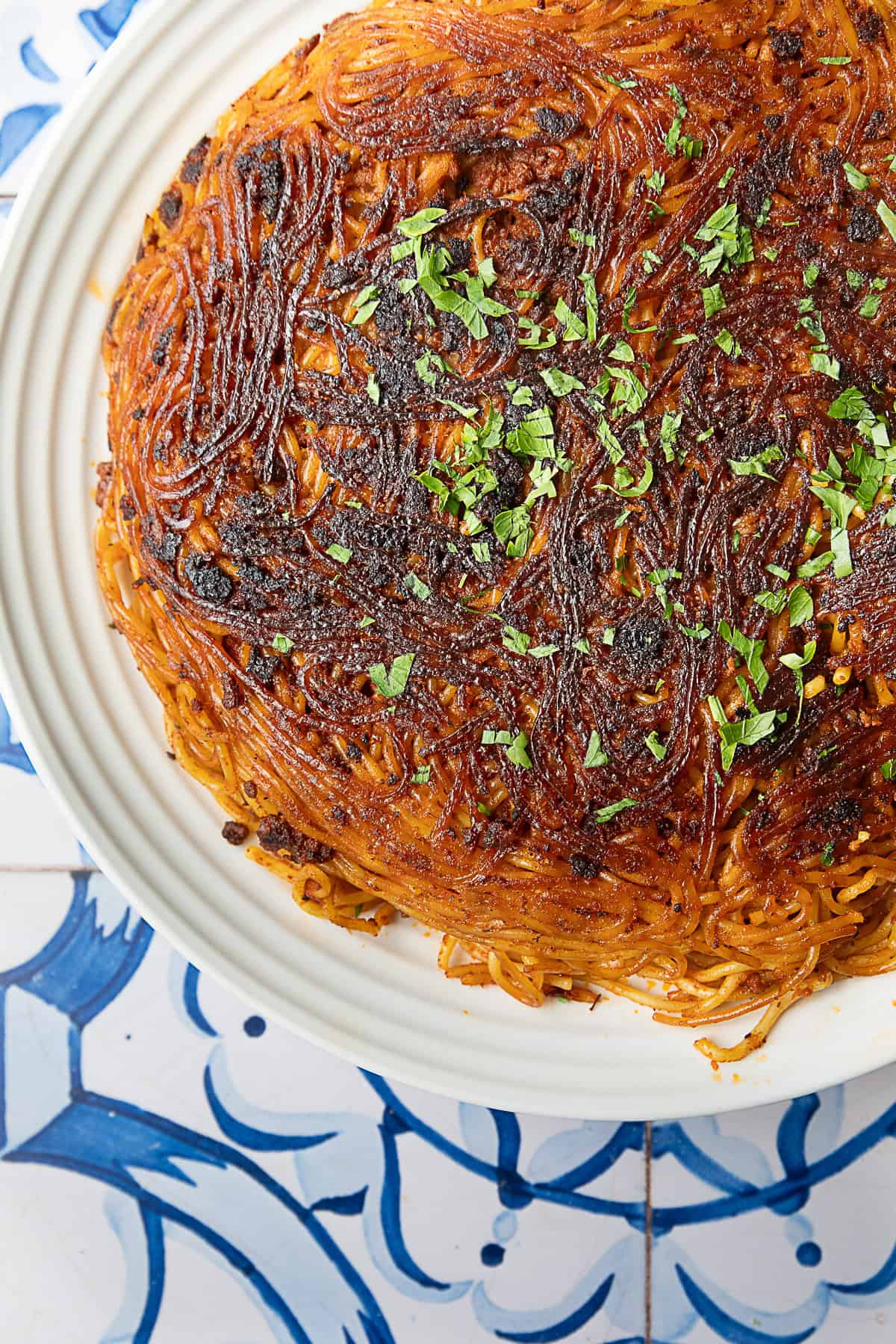
Key Ingredients
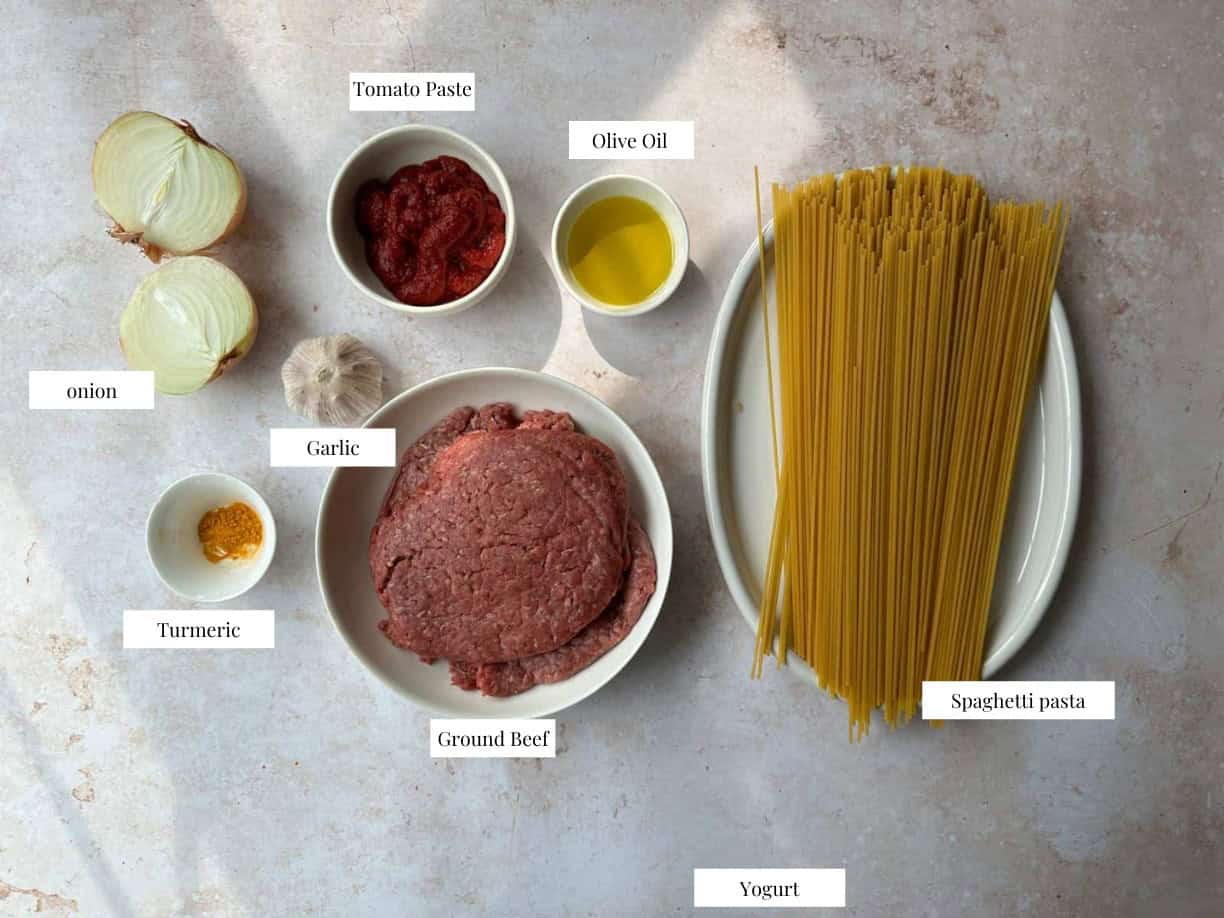
- Spaghetti: Although you can use other pasta shapes, spaghetti is the most popular one. It’s cooked al dente and then steamed with the sauce, which gives it a unique texture and allows it to absorb all the flavors.
- Olive oil: Used for sautéing the onions and mixing with the cooked spaghetti. It adds richness and helps the flavors meld together.
- Onions: The base of the meat sauce, it’s best to use white or yellow onions.
- Garlic: You don’t need much garlic, just enough to add flavor to the sauce.
- Ground beef: Brings a hearty, savory element to the dish. Be sure to break it up finely so it mixes well with the pasta. It’s best to use 85% to 90% lean ground beef.
- Tomato paste: Adds deep tomato flavor and a touch of sweetness that enriches the sauce.
- Turmeric: Gives a subtle earthy flavor and a warm, golden color, adding depth to the sauce.
- Oregano: Brings an aromatic note that pairs perfectly with the tomato and beef.
- Passata: You can technically mix tomato paste with water or use crushed tomatoes, but I prefer passata because it offers a smooth, rich tomato base that coats the pasta beautifully.
Ingredient Spotlight: Passata
Passata is a key ingredient in Persian-style spaghetti, offering a smooth, rich tomato base. The passata elevates the dish’s flavor and texture. Unlike regular tomato sauce or crushed tomatoes, passata is made from ripe, strained tomatoes that have been puréed to a velvety consistency. The result? An deal sauce for recipes that require a thick, smooth sauce without the chunks or seeds often found in other tomato products.
It’s a staple for creating authentic tomato-based sauces. Moreover, the smoothness of passata ensures that every strand of pasta is coated in a rich, flavorful sauce. This allows the spices and other ingredients to shine.
The taste of passata is naturally sweet and tangy. Furthermore, it offers a concentrated tomato flavor without the acidity that sometimes accompanies canned tomatoes. This makes it an excellent base for long-simmering sauces, as it deepens in flavor and melds beautifully with the spices and aromatics used in the dish. When combined with the sautéed onions, garlic, and ground beef in this recipe, passata creates a robust, comforting sauce that perfectly complements the steamed spaghetti.
How to Make Makaroni
Step 1: Prepare The Sauce
Heat the olive oil in a large pan over medium heat. Add the chopped onion and sauté until it becomes golden and fragrant, which should take about 7-10 minutes.
Next, add the minced garlic to the pan and cook for about a minute, just until it becomes aromatic. Then, add the ground beef followed by the spices. Cook, breaking up the meat with a spoon, until it’s fully browned and cooked through.
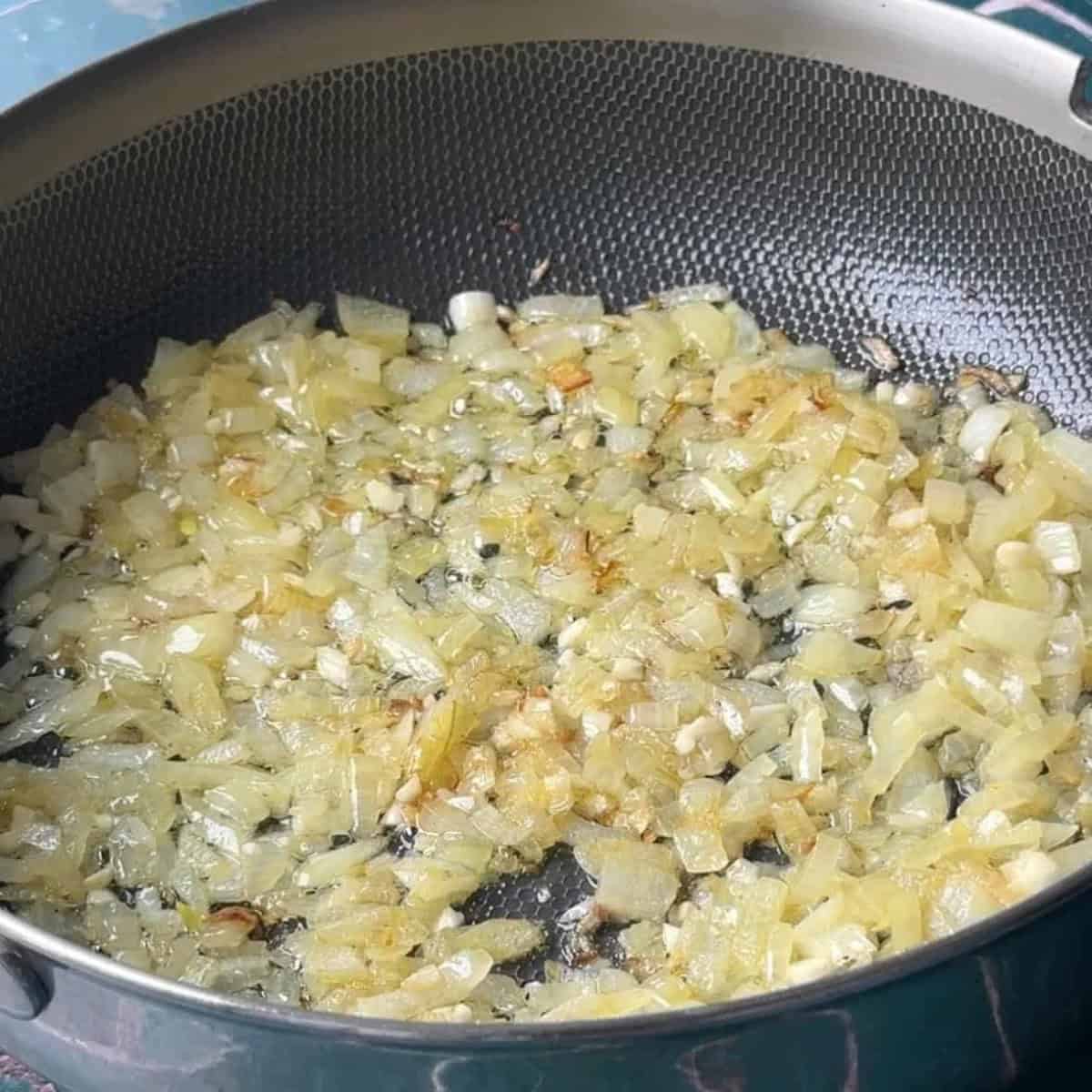

Step 2: Incorporate Tomato Paste and Spices
Stir in the tomato paste, making sure it’s evenly distributed. Cook for a few more minutes to let the flavors develop and the tomato paste to darken slightly.
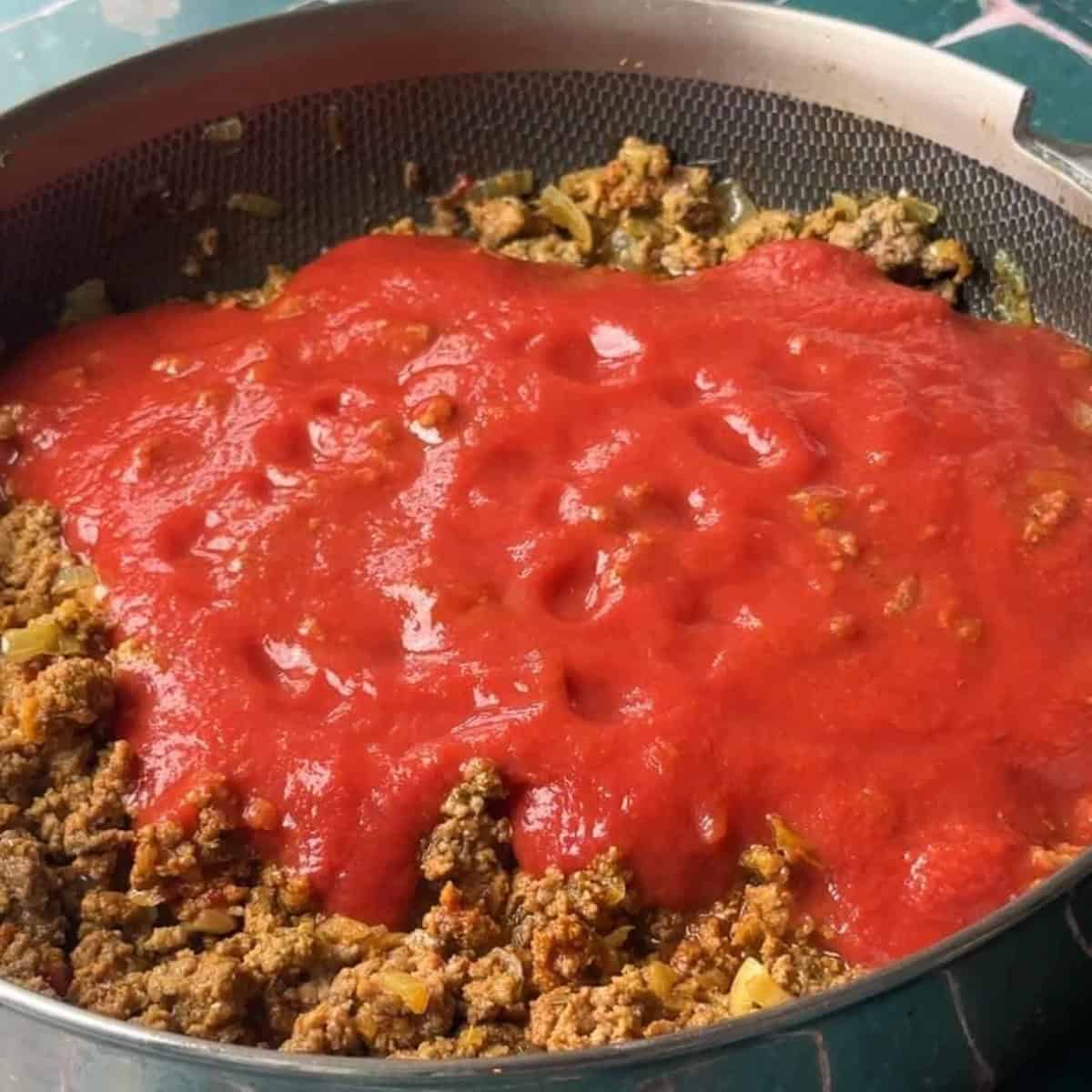
Step 3: Add Passata and Simmer
Pour in the passata and stir well. Cover the pan and let the sauce simmer on low heat for 30 to 40 minutes, allowing the flavors to meld together.
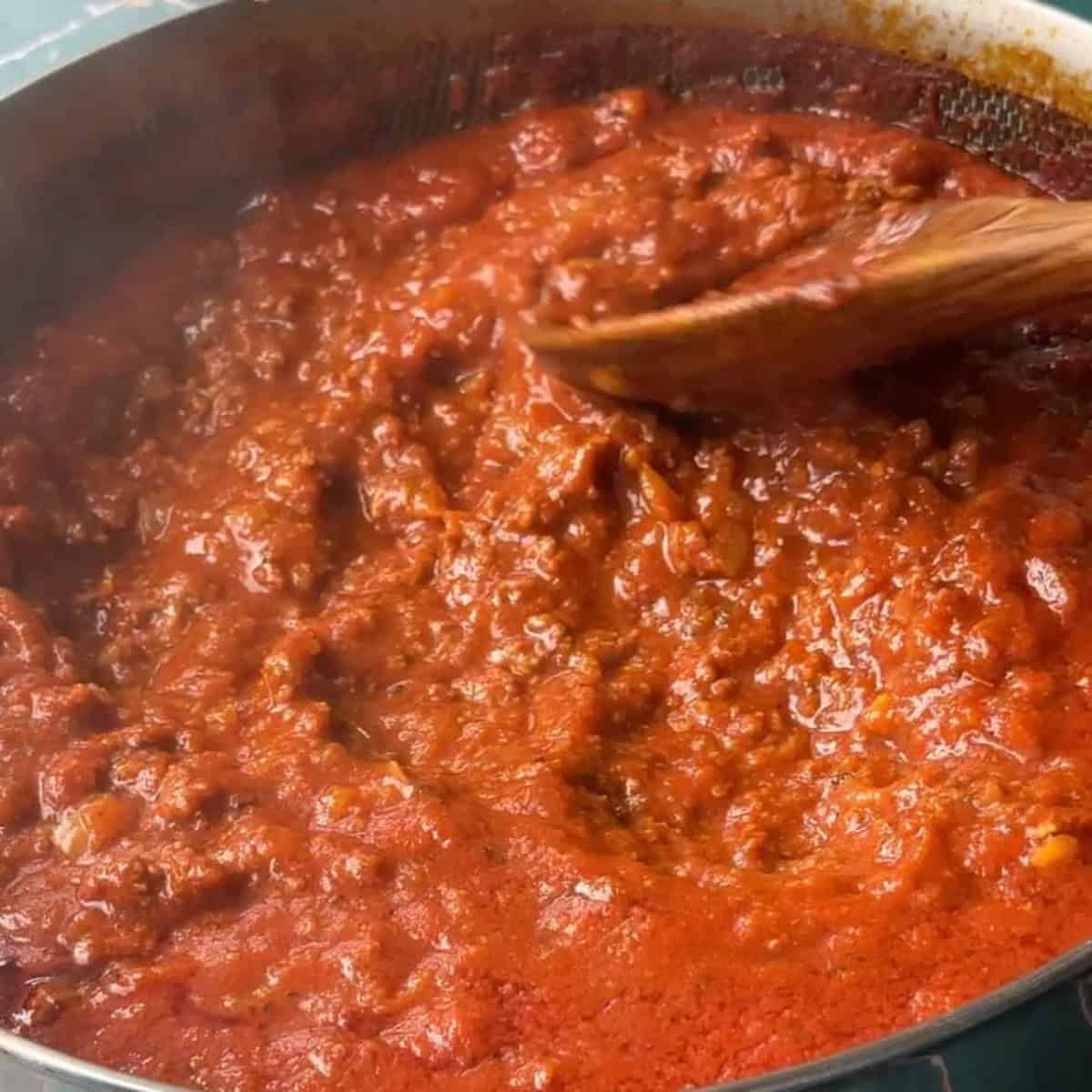
Step 4: Cook the Spaghetti
While the sauce is simmering, cook the spaghetti in a large pot of salted boiling water according to the package instructions until it’s al dente. Drain the pasta and toss it with a little olive oil to prevent sticking.
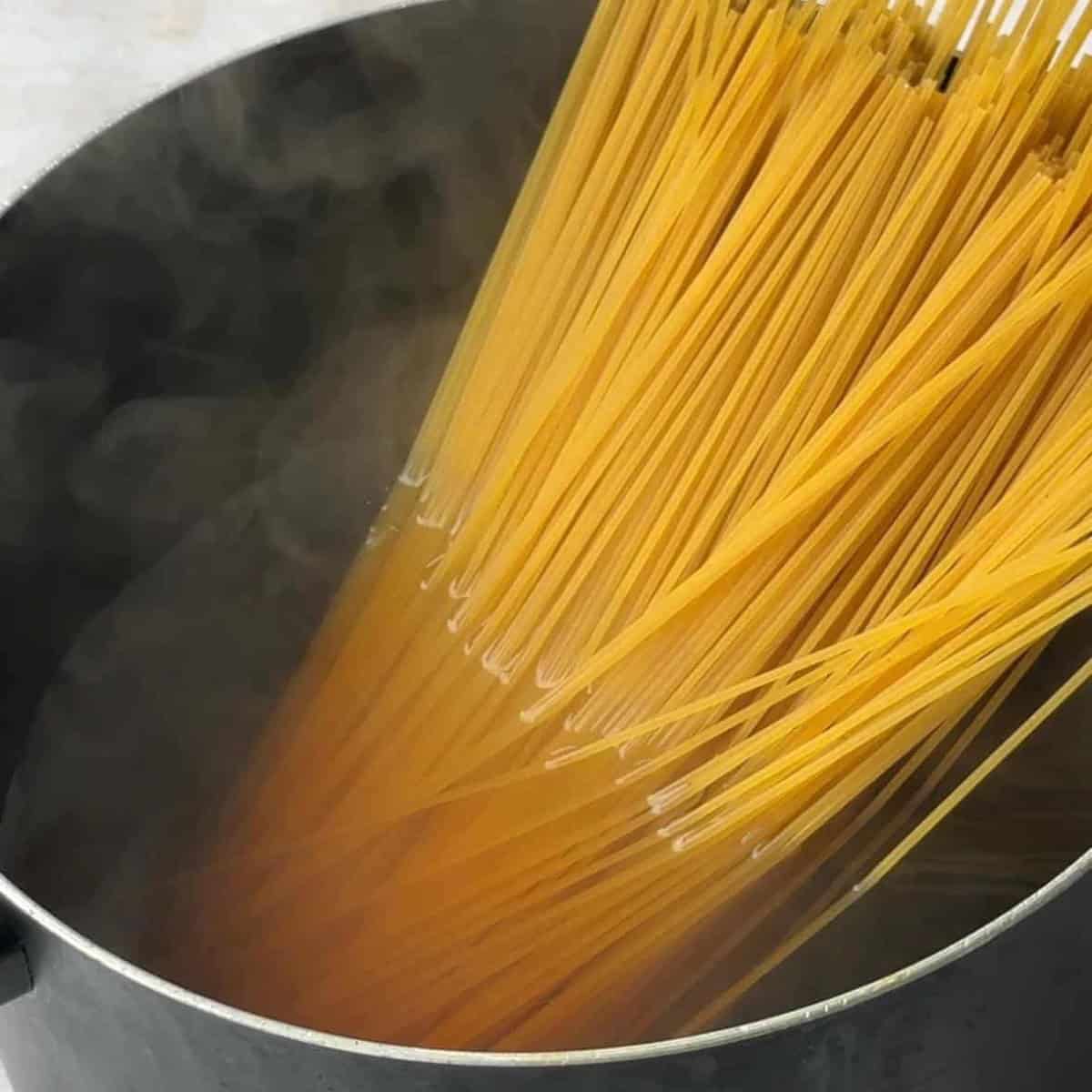
Step 5: Combine Pasta and Sauce
Once the sauce has thickened and developed its flavors, mix it with the cooked spaghetti in a large bowl. Ensure the pasta is well coated with the sauce.
Pour some oil into a large pan or a pot. Now, Transfer the pasta and sauce mixture to the pan. Cover tightly and cook over medium heat for about 40 minutes. This final step allows the pasta to absorb even more flavor and creates a crispy bottom layer, which will be the tahdig.


Step 6: Serve
Once the Makaroni is ready, you can either flip the entire dish onto a platter to reveal the crispy bottom or serve it directly from the pot. Enjoy your Persian Style Spaghetti with a side of fresh herbs or a simple salad.
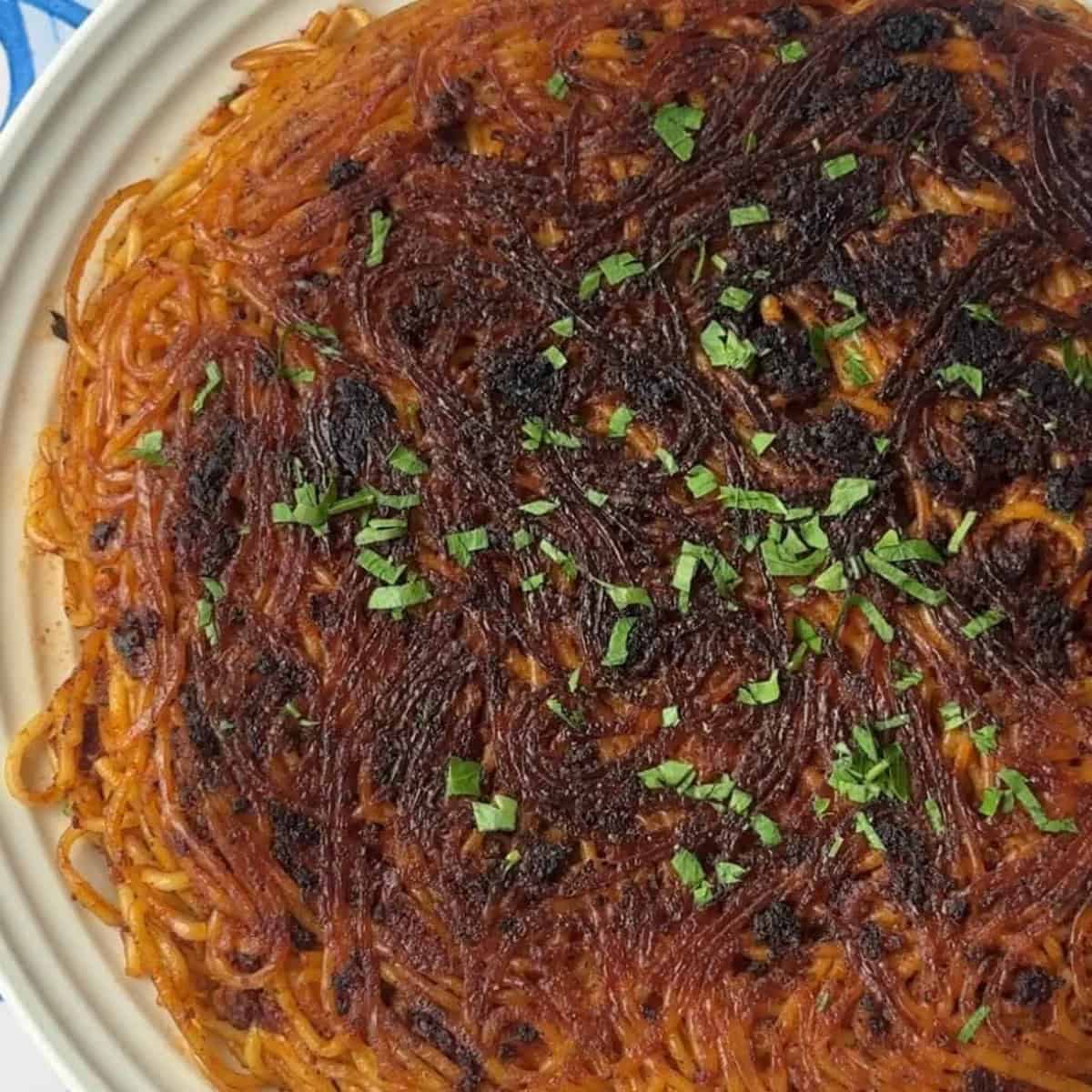
Serving Suggestions
You can serve makaroni with a variety of side dishes such as mast o khiar (Persian style yogurt and cucumber), salad shirazi or zeytoon parvardeh (marinated olives).
Recipe Tips
Sautéing the Onion: Take your time to sauté the onion until it’s a rich golden brown. This step builds a deep flavor base for your sauce and is key to achieving the authentic taste of Persian Makaroni.
Properly Seasoning the Meat: Ensure you season the ground beef generously as it cooks. The meat should be well seasoned to enhance the overall flavor of the dish, as it is the heart of the sauce.
Choosing the Right Tomato Product: Use passata or crushed tomatoes for the sauce. Passata provides a smoother, richer texture that’s ideal for this dish, but if it’s unavailable, crushed tomatoes work as a substitute. Avoid using tomato sauce as it may alter the flavor and consistency.
Simmering the Sauce: Allow the sauce to simmer for a full 30 to 40 minutes. This slow cooking process helps the flavors meld together and reduces the sauce to the perfect consistency.
Undercooking the Pasta: Cook the spaghetti just until it’s al dente, meaning it still has a bit of bite to it. The pasta will continue cooking during the steaming process, and overcooked pasta can become mushy.
Creating a Crispy Bottom Layer (Tahdig): When steaming the Makaroni in the pot, ensure it’s on medium-low heat and tightly covered. This step allows the pasta at the bottom to crisp up, creating a delicious tahdig. If you’re feeling adventurous, you can even line the bottom of the pot with thin potato slices before adding the pasta for an extra crispy layer.
Flipping the Makaroni: To achieve the best presentation, use a large platter to flip the Makaroni out of the pot, so the crispy bottom layer is on top. This not only looks impressive but also ensures everyone gets a taste of the prized tahdig.
Resting Before Serving: Let the Makaroni rest for a few minutes after flipping. This allows the flavors to settle and makes it easier to slice and serve without the dish falling apart.

Variations and Substitutes
Different Meats:
- Ground Lamb: For a richer, more traditional flavor, substitute ground lamb for ground beef. Lamb adds a distinct taste that pairs beautifully with the spices in this dish.
- Sausage: Crumbled sausage, especially a mildly spiced one, can add an extra depth of flavor. This variation is a great way to introduce more complexity to the dish.
Vegetarian Makaroni:
- Mushrooms: Replace the ground meat with finely chopped mushrooms for a hearty vegetarian option. Mushrooms provide a meaty texture and absorb the flavors of the sauce.
Pasta Types:
- Other Shapes: While spaghetti is the traditional choice, other pasta shapes like penne, fusilli, or bowtie (farfalle) can be used. These shapes hold the sauce differently and add a unique texture to the dish.
- Gluten-Free Pasta: For those with dietary restrictions, gluten-free pasta can be used in place of regular spaghetti. Be mindful of the cooking time, as gluten-free pasta can become mushy if overcooked.
Additional Vegetables:
- Bell Peppers: Add chopped bell peppers to the sauce for extra sweetness and a pop of color. They also complement the flavors of the tomato and spices.
Tahdig Variations:
- Potato Tahdig: For a twist on the classic pasta tahdig, line the bottom of the pot with thinly sliced potatoes before adding the spaghetti. This creates a golden, crispy layer that adds a delicious crunch to the dish.
- Bread Tahdig: Another variation is to use flatbread or lavash to create a bread tahdig at the bottom of the pot. The bread soaks up the flavors of the sauce and becomes wonderfully crisp.

How to Store Makaroni
Refrigerating:
- Short-Term Storage: Place any leftover Makaroni in an airtight container. Store it in the refrigerator for up to 3-4 days. Reheat in a pan over medium heat or in the microwave, adding a splash of water or extra sauce to prevent it from drying out.
Freezing:
- Long-Term Storage: For longer storage, you can freeze Makaroni. Transfer it to a freezer-safe container, leaving some space at the top to allow for expansion. Freeze for up to 3 months. When ready to eat, thaw it in the refrigerator overnight and reheat on the stovetop or in the microwave.
Reheating:
- Oven Method: Preheat the oven to 350°F (175°C). Place the Makaroni in an oven-safe dish, cover with foil, and heat for 20-25 minutes, or until warmed through. This method helps to retain the texture of the pasta and sauce.
- Microwave Method: For a quick reheat, transfer a portion of Makaroni to a microwave-safe dish, cover with a microwave-safe lid or plastic wrap, and heat in 1-minute intervals, stirring in between, until hot.
Avoiding Dryness:
- Extra Sauce: If you find that the pasta has absorbed too much of the sauce while stored, add a little extra passata or a splash of water when reheating to keep the dish moist and flavorful.

Frequently Asked Questions
Tahdig is the crispy layer that forms at the bottom of the pot during the final cooking stage. To achieve a perfect tahdig, make sure the heat is moderate, and don’t disturb the pasta while it’s steaming. You can also use a non-stick pot to help with the release of the crispy layer when flipping the dish.
Yes, you can prepare the meat sauce ahead of time and store it in the refrigerator for up to 3 days. When ready to serve, cook the pasta, mix it with the sauce, and proceed with the steaming step.
To prevent the pasta from sticking, ensure it’s cooked al dente and tossed with the sauce before steaming. Adding a bit of olive oil to the pasta before mixing with the sauce can also help.
If passata is not available, you can substitute it with crushed tomatoes or a blend of tomato purée and a bit of water. Just be sure to simmer it longer to achieve the desired consistency.
Yes, while spaghetti is the traditional choice for Makaroni, you can substitute it with other types of pasta like penne, bowtie, or rigatoni. Just make sure to adjust the cooking time as needed.
Other Delicious Pasta Dishes to Try
Rice and Pasta
Chicken Parmesan Pasta [Video]
Rice and Pasta
Italian Sausage Pasta Recipe
Rice and Pasta
Cherry Tomato Pasta
Vegetarian
Creamy Spinach Pesto Pasta Recipe
Did you make this recipe? I’d love to hear about it! Please comment and leave a 5-star🌟 rating below. You can also follow us on Instagram, Facebook, Pinterest or subscribe to our newsletter to get a free e-Cookbook!
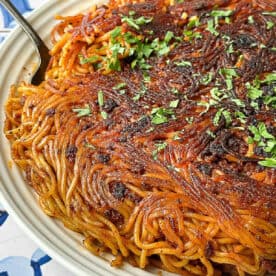
Makaroni (Persian Spaghetti)
Ingredients
- 1/3 cup Olive oil
- 1 large Onion, chopped
- 2 cloves Garlic, minced
- 1 pound Ground beef
- ½ tsp Turmeric
- 1 tsp Salt
- ½ tsp Black pepper
- 1 tsp Oregano
- 3 tbsp Tomato paste
- 24 oz Passata
- 1 pound Spaghetti
Instructions
- Heat 2 tablespoons of the olive oil in a pan over medium high heat. Sauté the onion until golden.
- Add the garlic and cook for a minute. Then, add the ground beef and the spices and cook until brown, making sure to break the meat apart.
- Add the tomato paste and cook for a few minutes, then add the passata and cover. Cook for 30 to 40 minutes.
- Meanwhile, cook the pasta according to the packaging in salty water. Drain and transfer to a large bowl. Toss with a drizzle of olive oil to avoid sticking.
- Add the meat sauce to the pasta and gently mix to combine. Pour the rest of the olive oil into a large pan (or a pot) and transfer the pasta to the pan. Cover and cook over medium heat for 40 minutes.
- The pasta is ready once the bottom is golden and crispy. Flip, let it cool for a few minutes and enjoy.
Video
Notes
Nutrition
Nutrition information is automatically calculated, so should only be used as an approximation.













What a beautiful, thorough post! Thank you so much!